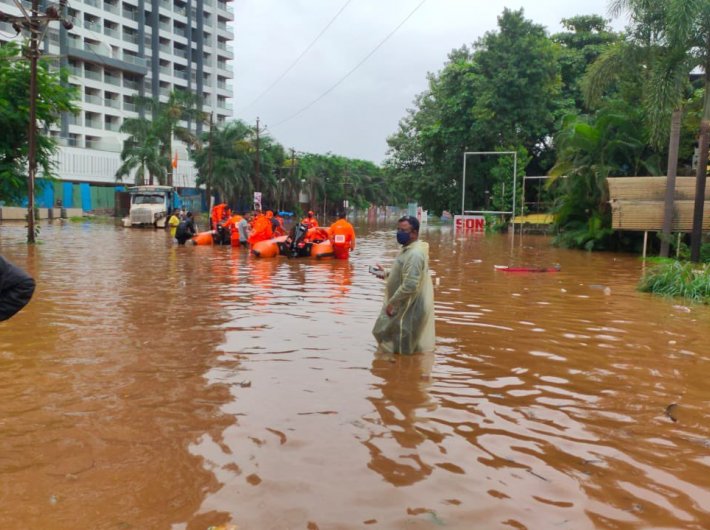CSE’s new report on extreme weather gives damage update: 1.8 mn hectares of crop area affected, 4 lakh+ houses destroyed, 70,000 heads of livestock killed
India recorded extreme weather events on 242 of the 273 days by September 30 this year. In other words, more than 88% of the time over these nine months, the country was witnessing an extreme weather event of some sort happening in one or more of its regions.
This has emerged from a new assessment by the Centre for Science and Environment (CSE) and ‘Down To Earth’ magazine, released here Tuesday. The assessment provides a comprehensive overview of the state of extreme weather in India across a major part of the year.
To download the new report, please visit: https://www.downtoearth.org.in/climate-change
‘Down To Earth’ has also launched ‘India’s Atlas on Weather Disasters’, an online public interactive database on extreme weather events that would be updated every month.
“What the country has witnessed so far in 2022 is the new abnormal in a warming world. There is a clear spike in frequency and intensity of extreme events that we are seeing,” said CSE director general Sunita Narain while releasing the report.
“Our report provides season-wise, month-wise and region-wise analysis of extreme weather events and their associated loss and damage. It is an attempt to build an evidence base on the frequency and expanding geography of extreme weather events in India. This is extremely important as the data that is publicly available on this subject is fragmented and fails to provide the overall picture,” added Narain.
Highlights of the report:
• A disaster almost every day: India has seen close to a disaster every day in the nine months of this year – from heat and cold waves, cyclones and lightning to heavy rains, floods and landslides.
• Loss and damage under-estimated: These disasters have claimed 2,755 lives, affected 1.8 million hectare of crop area, destroyed over 416,667 houses and killed close to 70,000 livestock. Says Rajit Sengupta, associate editor of Down To Earth and one of the writers of the report: “This estimation of loss and damage is probably an underestimate as data for each event – including losses of public property or crop loss – has not been collated or estimated.”
• With an event every second day, Madhya Pradesh saw the highest number of days with extreme weather events, but Himachal Pradesh saw the highest number of human fatalities – 359 deaths. Madhya Pradesh and Assam witnessed 301 human deaths each.
• Assam reported the highest number of damaged houses and animal deaths.
• Karnataka, which experienced an extreme weather event on 82 days, accounted for more than 50% of the crop area affected in the country. Madhya Pradesh, as per official records, did not report any crop area damage. Sengupta says this could be due to “gaps in loss and damage reporting”.
• The central and north-western regions reported the highest number of days with extreme weather events at 198 and 195, respectively. In terms of human lives lost, central India topped the list with 887 deaths, followed by the east and northeast (783 deaths).
• Warmest, wettest, driest: In 2022, India recorded its seventh wettest January since 1901. This March was also the warmest ever and the third driest in 121 years. It was also the country’s third warmest April, 11th warmest August and 8th warmest September since 1901.
• Eastern and northeastern India saw its warmest and driest July in 121 years. The region also recorded its second warmest August and fourth warmest September in 2022.
• In terms of the ‘nature’ of the event, all types of extreme weather have been seen in the past nine months – lightening and storms were spread over 30 states and claimed 773 lives. Every day of the three months of monsoon – from June to August – indicate heavy to very heavy and extremely heavy rainfall in some parts of the country. This is why the flood devastation has not spared any region – in Assam, for instance, vast parts of the state were submerged leading to loss of lives, property and livelihoods.
• Heat waves claimed 45 lives, but what is not captured in the official data is the impact of the prolonged high temperatures on people’s well-being in north India – from farmers to construction workers – and how they coped with the intense and searing heat.
• The good news is that fatalities because of cyclones were few – only two lives were lost according to available data from cyclones that destroyed 95,066 hectare in the country. Said Narain: “This is because of the amazing work done by the India Meteorological Department (IMD) on cyclone forecasting so that there is adequate warning to governments. It is also because state governments – particularly those in Odisha, Andhra Pradesh and West Bengal – have improved their systems of disaster management.”
